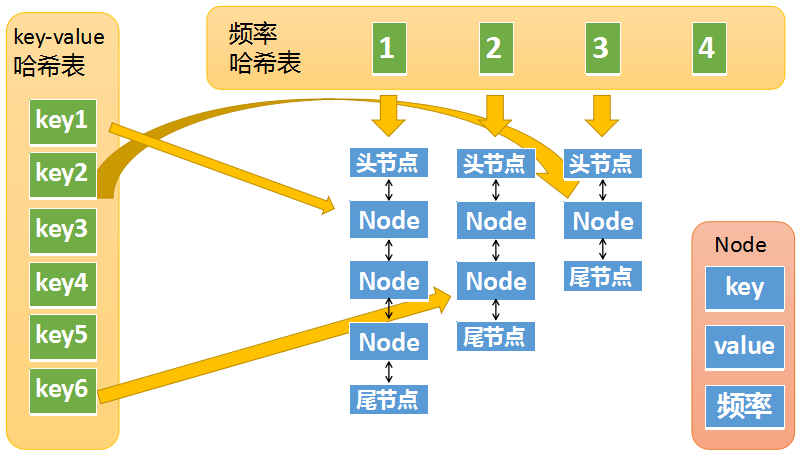本文最后更新于:2022年4月9日 中午
实现 LFU 缓存数据结构。
参考:力扣—460 LFU缓存
LFUCache(int capacity) - 用数据结构的容量 capacity 初始化对象int get(int key) - 如果键存在于缓存中,则获取键的值,否则返回 -1。void put(int key, int value) - 如果键已存在,则变更其值;如果键不存在,请插入键值对。当缓存达到其容量时,则应该在插入新项之前,使最不经常使用的项无效。在此问题中,当存在平局(即两个或更多个键具有相同使用频率)时,应该去除 最久未使用 的键。
参考题解:@王尼玛
- 两个哈希表 + N个双链表
- key-node 哈希表、freq-LinkedList 哈希表

第一个 freq_table 以频率 freq 为索引,每个索引存放一个双向链表,这个链表里存放所有使用频率为 freq 的缓存,缓存里存放三个信息,分别为键 key,值 value,以及使用频率 freq。
第二个 key_table 以键值 key 为索引,每个索引存放对应缓存在 freq_table 中链表里的内存地址,这样我们就能利用两个哈希表来使得两个操作的时间复杂度均为 O(1)。同时需要记录一个当前缓存最少使用的频率 minFreq,这是为了删除操作服务的。
对于 get(key) 操作,我们能通过索引 key 在 key_table 中找到缓存在 freq_table 中的链表的内存地址,如果不存在直接返回 -1,否则我们能获取到对应缓存的相关信息,这样我们就能知道缓存的键值还有使用频率,直接返回 key 对应的值即可。
但是我们注意到 get 操作后这个缓存的使用频率加一了,所以我们需要更新缓存在哈希表 freq_table 中的位置。已知这个缓存的键 key,值 value,以及使用频率 freq,那么该缓存应该存放到 freq_table 中 freq + 1 索引下的链表中。
void put(int key, int value)
对于 put(key, value) 操作,我们先通过索引 key在 key_table 中查看是否有对应的缓存,如果有的话,其实操作等价于 get(key) 操作,唯一的区别就是我们需要将当前的缓存里的值更新为 value。如果没有的话,相当于是新加入的缓存,如果缓存已经到达容量,需要先删除最近最少使用的缓存,再进行插入。
先考虑插入,由于是新插入的,所以缓存的使用频率一定是 1,所以我们将缓存的信息插入到 freq_table 中 1 索引下的列表头即可,同时更新 key_table[key] 的信息,以及更新 minFreq = 1。
考虑删除操作了,由于我们实时维护了 minFreq,所以我们能够知道 freq_table 里目前最少使用频率的索引,同时因为我们保证了链表中从链表头到链表尾的插入时间是有序的,所以 freq_table[minFreq] 的链表中链表尾的节点即为使用频率最小且插入时间最早的节点,我们删除它同时根据情况更新 minFreq ,整个时间复杂度均为 O(1)。
代码看看就好。。。
1
2
3
4
5
6
7
8
9
10
11
12
13
14
15
16
17
18
19
20
21
22
23
24
25
26
27
28
29
30
31
32
33
34
35
36
37
38
39
40
41
42
43
44
45
46
47
48
49
50
51
52
53
54
55
56
57
58
59
60
61
62
63
64
65
66
|
struct Node {
int key, val, freq;
Node(int _key,int _val,int _freq): key(_key), val(_val), freq(_freq){}
};
class LFUCache {
int minfreq, capacity;
unordered_map<int, list<Node>::iterator> key_table;
unordered_map<int, list<Node>> freq_table;
public:
LFUCache(int _capacity) {
minfreq = 0;
capacity = _capacity;
key_table.clear();
freq_table.clear();
}
int get(int key) {
if (capacity == 0) return -1;
auto it = key_table.find(key);
if (it == key_table.end()) return -1;
list<Node>::iterator node = it -> second;
int val = node -> val, freq = node -> freq;
freq_table[freq].erase(node);
if (freq_table[freq].size() == 0) {
freq_table.erase(freq);
if (minfreq == freq) minfreq += 1;
}
freq_table[freq + 1].push_front(Node(key, val, freq + 1));
key_table[key] = freq_table[freq + 1].begin();
return val;
}
void put(int key, int value) {
if (capacity == 0) return;
auto it = key_table.find(key);
if (it == key_table.end()) {
if (key_table.size() == capacity) {
auto it2 = freq_table[minfreq].back();
key_table.erase(it2.key);
freq_table[minfreq].pop_back();
if (freq_table[minfreq].size() == 0) {
freq_table.erase(minfreq);
}
}
freq_table[1].push_front(Node(key, value, 1));
key_table[key] = freq_table[1].begin();
minfreq = 1;
} else {
list<Node>::iterator node = it -> second;
int freq = node -> freq;
freq_table[freq].erase(node);
if (freq_table[freq].size() == 0) {
freq_table.erase(freq);
if (minfreq == freq) minfreq += 1;
}
freq_table[freq + 1].push_front(Node(key, value, freq + 1));
key_table[key] = freq_table[freq + 1].begin();
}
}
};
|
